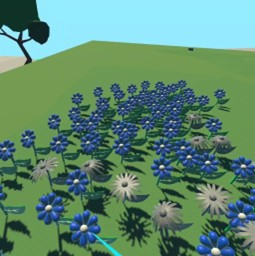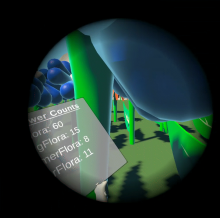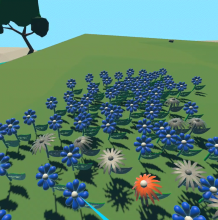An immersive bee simulation that reveals how online content can become an echo chamber.
What happens when algorithms only show us what we already agree with? This project uses virtual reality (VR) to help users understand the concept of a filter bubble—a digital phenomenon in which personalized content limits exposure to diverse viewpoints.
To help people better understand this concept, researchers from the Rochester Human Computer Interaction group (ROCHCI) partnered with Studio X to develop an immersive VR experience that brings the filter bubble to life—through the eyes of a bee.
About the Experience
Players take on the role of a bee exploring a virtual, multi-species garden. Each flower type represents a different category of information or perspective. As players "pollinate" certain flowers, more of that type appear—while others gradually fade away.
Over time, the once-diverse ecosystem becomes dominated by a single species, limiting the player’s view and options. This transformation parallels how algorithms on digital platforms can lead to information bubbles, reinforcing familiar viewpoints and filtering out the rest.
Vision Blocked by Monoculture: Reinforced Biases

Scenario: As pollination progresses, the bee's surroundings become increasingly filled with just one type of flower. Eventually, the dense presence of a single species may block the bee's view, making it difficult to find alternative flowers.
Real-life analogy: When an individual engages mostly with one specific content type, they may encounter similar ideas. This will reinforce biases and make it challenging to access alternative or opposing perspectives.
Dominant Flower: Loss of Perspective Diversity

Scenario: As the bee consistently pollinates the same flower type, this allows that type of flower to dominate the scene, reducing diversity in the garden and limiting the bee's choices.
Real-life analogy: Extreme filter bubbles lead to polarization. People struggle to access unbiased news, opposing viewpoints, or diverse discussions, making it difficult to form a well-rounded understanding of the world.
Key Features
- First-Person Bee Perspective
Players experience the garden from a bee’s-eye view, with full six degrees of movement (6DoF), creating a sense of embodied exploration and agency.
- Dynamic Garden Ecosystem
The virtual garden begins with a balance of four flower types. As the bee pollinates, that type reproduces, while others begin to decay—visually representing how digital content personalization evolves.
- Pollination and Decay Mechanic
Clicking on flowers to pollinate them initiates the spread of similar flowers, while alternative types slowly disappear—mirroring how engagement with specific content narrows exposure.
- Real-Time Visual Feedback
A user interface shows the number and distribution of flower types in real time, allowing players to observe how their choices influence the environment.
- Reset Mechanism
When one flower type dominates the garden completely, a reset button activates, encouraging players to reflect and start again.
Why a Bee? Why a Garden?
The project explores the concept of the filter bubble, a term coined to describe how personalization algorithms limit the variety of information we encounter online. By translating this abstract idea into a playful, embodied experience, the project makes the filter bubble more relatable and visible. The bee-and-garden metaphor helps users feel the consequences of narrowing perspectives in a way that is both intuitive and impactful. As players watch their world shift from rich diversity to monoculture, they are prompted to think critically about the digital environments they inhabit every day.






